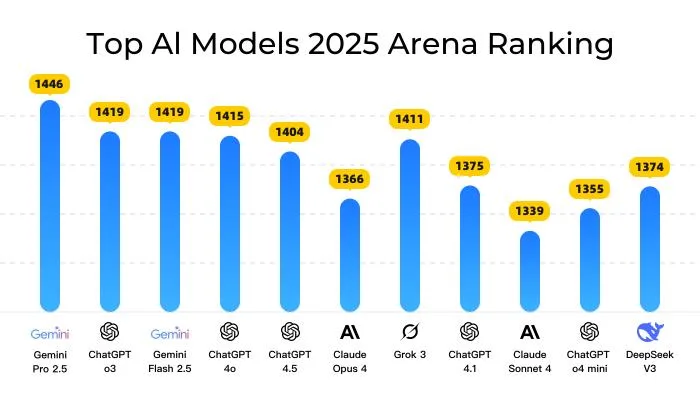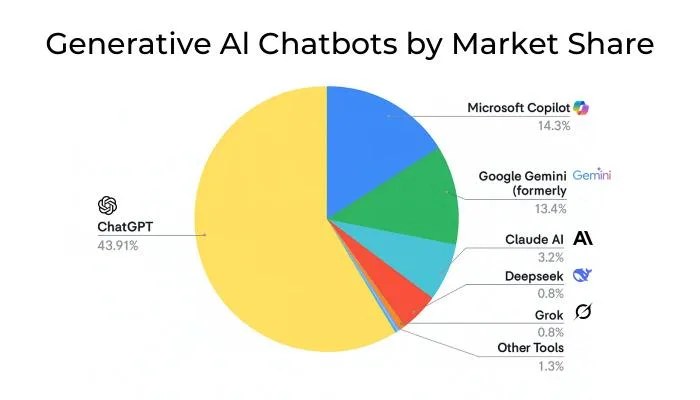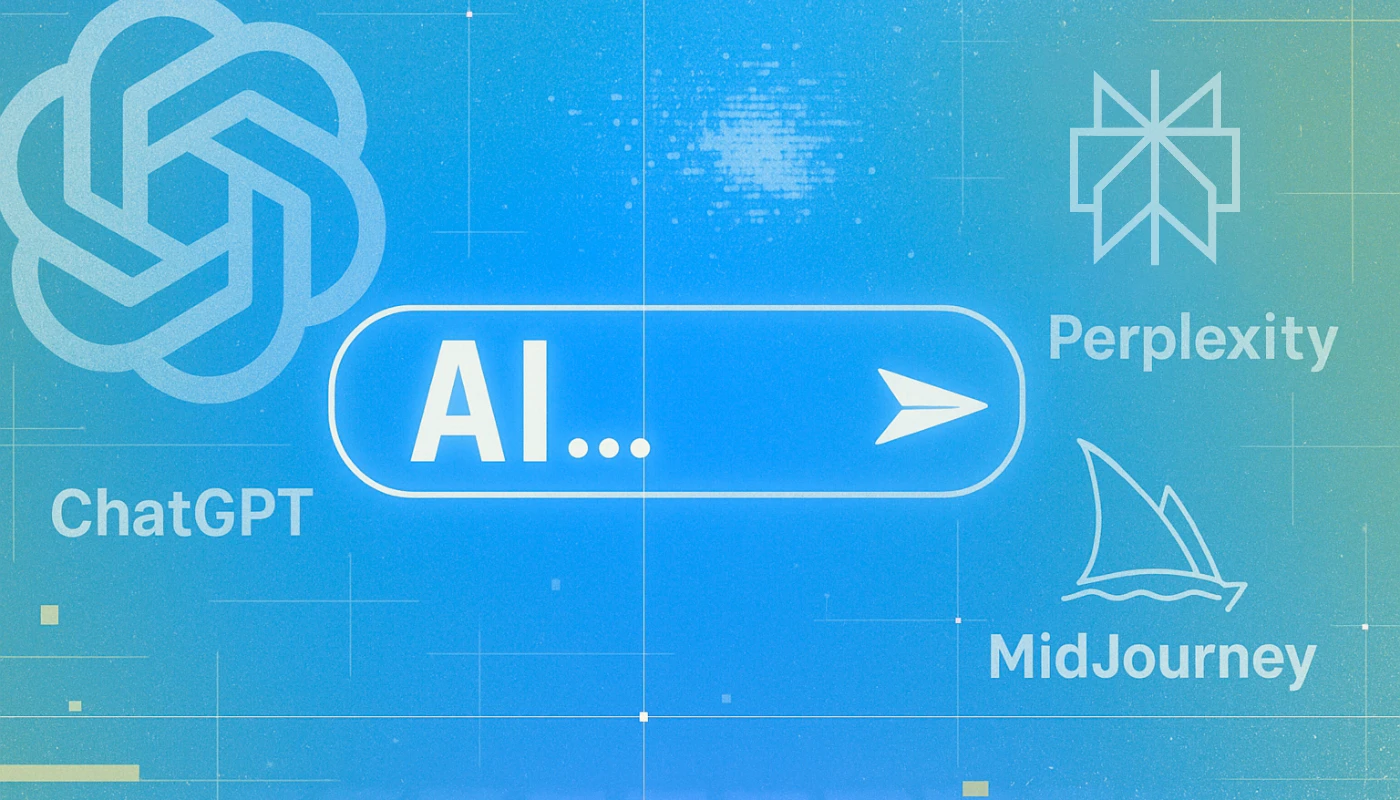Use ChatGPT to quickly summarize documents, improve coding efficiency through GitHub Copilot, or use Canva AI to easily design posters and presentations - these application scenarios can now be seen everywhere in daily life.
Behind these changes in your and my work and life is actually an accelerating artificial intelligence revolution.
Statista forecasts that the global AI market will surpass $244 billion by 2025, while a McKinsey survey shows that 78% of companies have already integrated AI into their core operations. AI is no longer the exclusive domain of tech giants; it’s an inevitable part of everyone’s reality.
Whether you're a casual user or a business leader, understanding AI trends could be the key to gaining a competitive edge in 2025. Curious about what the future holds? Here’s a look at the five major AI trends we’ve identified for 2025.
Why Should You Care About AI Trends in 2025
AI trends are evolving rapidly and increasingly impacting everyone. Keeping an eye on AI developments not only helps businesses and individuals seize new opportunities, but also avoid being left behind by emerging technologies. Here are the specific reasons:
Spot Emerging Opportunities: New commercial demands and opportunities are emerging from AI. Innovations like multimodal AI and emotion recognition are enabling services such as companion robots, medical voice assistants. Staying on top of AI trends helps you seize these chances and lead the industry.
Make Smarter Decisions: Tracking AI trends helps businesses and individuals identify which technologies are mature and which still need time, allowing them to invest their budgets in areas with real potential.
Boost Efficiency and Productivity: The new generation of AI tools can automatically handle repetitive and time-consuming tasks, such as automated report generation and large-scale data analysis, allowing you to focus your energy on more creative work.
Avoid Potential Risks: The development of AI technology brings new ethical issues, such as privacy protection and data security, while AI-related regulatory policies and laws are also being continuously improved. Paying attention to these developments can help you take effective measures in advance to ensure compliance and legality.
Enhance Customer Experience: AI helps organizations improve customer experience in many ways. They can improve customer satisfaction by providing more convenient services through intelligent interactions, personalized recommendations, or automated customer support systems.
AI Models Will Become Smarter and More Useful
Over the past year, AI models have made significant leaps forward. By 2025, we will witness further breakthroughs in their capabilities.
Next-gen models like OpenAI’s o1 now simulate human reasoning and handle complex tasks such as contract customization, code generation, legal analysis, and financial forecasting.
In addition, improvements in training methods are making AI models more efficient and accurate. For example, DeepSeek-V3 reduces latency through architectural optimization, while Claude 3.7 Sonnet uses “chain-of-thought reinforcement” to better understand context and deliver precise answers.
These advancements will ultimately lead to smoother and smarter interactions in our daily use. As AI technology spreads, personalized AI models will become increasingly common. Each person and organization can choose the models that best suit their needs.
As Botpress notes, “AI in 2025 is getting even more personal.” This is not only the direction in which technology is heading, but also a shift that will redefine each individual's relationship with AI.
Next-Gen LLMs: More Powerful and Cost-Efficient
LLMs are a subset of language models, typically more complex and more powerful. Representative examples include ChatGPT, Claude, and Gemini, capable of fluent text generation and complex tasks such as translation, summarization, coding, and data analysis.
By 2025, LLMs will have dramatically improved from the slow, vague responses of previous years to delivering almost instant, high-quality answers tailored to specific situations. For instance, when asked about intellectual property protection, today’s models provide detailed, actionable steps tailored to your situation.
The fact that these advances were cheaper than projected is even more impressive. For example, DeepSeek-V3 achieved GPT-4-level capabilities while costing only one-third as much to train.
Lower costs and greater capabilities mean that in the future, high-quality AI will benefit more people at a faster speed and with lower thresholds.
Multimodal AI: Beyond Text—Vision, Speech, and More
Compared to large language models focused solely on text, Multimodal AI can understand and generate multiple data types—text, images, audio, and more—breaking down barriers between isolated information sources.
By 2025, Multimodal AI will have evolved from handling basic questions to sophisticated reasoning across different modalities. Gemini 2.5 Pro, for example, processes multimodal inputs at the million-token level, analyzes up to four hours of meeting recordings in real time, and produces summaries and charts with 92.7% semantic accuracy.
As these applications expand, the commercial value of multimodal AI is rapidly increasing. By 2025, the global market exceeded $2.5 billion, with projections reaching $4.5 billion by 2028, growing at a 35% CAGR.
It is foreseeable that in the future, multimodal AI will be deeply integrated into all industries, bringing more efficient and natural human-AI interaction to the way we work and live.
AI Model Rankings: Who’s Leading the Race in 2025?
AI model competition in 2025 is changing as model capabilities improve. To better understand their real-world performance, we referred to the latest ratings from Chatbot Arena to conduct a comprehensive evaluation of mainstream models.

According to the latest Chatbot Arena scores, the gap between leading models is gradually narrowing. Gemini 2.5 Pro leads with 1446, followed closely by Gemini 2.5 Flash and ChatGPT o3 (both at 1419), GPT-4o (1415), and Grok 3 (1411), indicating that AI capabilities are moving toward greater stability and maturity.
In terms of user preferences, the ChatGPT series holds a dominant lead with 43.91% market share, well ahead of Microsoft Copilot (14.3%) and Google Gemini (13.4%). While technically competitive, models like Claude, DeepSeek, and Grok still face limited market penetration.

This trend shows that the focus of artificial intelligence is shifting from performance competition to the ease of use and comprehensive experience of products. AI is no longer just a technical demonstration, but plays an increasingly practical role in daily life.
In this context, GamsGo AI provides users with a multi-model, multi-modal aggregation entrance, allowing everyone to experience the true capabilities of AI with a lower threshold and higher efficiency. Not only can you freely switch between conversational models such as ChatGPT, Claude, and Gemini, but it also supports image generation using MidJourney, video creation through Runway and Kling, and music generation with Suno, etc.
GamsGo AI also provides free trial opportunities for some models to help users understand the functions and differences of different models , so as to choose the most suitable tool. It is through such exploration that AI can truly integrate into our work and life and play its practical value.
AI Applications Across Industries in 2025
In recent years, AI has taken on a growing role in daily work, beyond writing meeting notes and reports, it now tackles complex tasks like weather forecasting and construction scheduling. For many industries, AI not only boosts efficiency but is transforming how work is done.
In 2025, this trend has become even more evident—artificial intelligence is breaking through traditional boundaries and playing a transformative role in industry development.
So, how effective is it in practice? Next, we’ll focus on three key sectors—healthcare, manufacturing, and retail to assess AI’s current applications and future potential.
AI in Healthcare: Accelerating Innovation
In 2025, AI will have a deeper impact on healthcare. It is no longer just an auxiliary tool for doctors, but a key force driving medical innovation.
In the field of precision medicine, AI is providing higher-level support, not only assisting in identifying complex diseases, but also contributing to the development of personalized treatment plans and drug selection.
For instance, Seoul National University Hospital launched the OncoDeep system in 2025, which uses patients' genomic data to match them with the most suitable combination of targeted cancer drugs—significantly enhancing treatment accuracy.
At the same time, AI is advancing preventive healthcare. Through large-scale data mining, AI models can detect potential health risks well in advance. A study published by Mayo Clinic in early 2025 revealed that their AI system could identify the risk of atrial fibrillation more than six months before symptoms appear, allowing for timely intervention.
Looking ahead, AI in healthcare won’t be limited to large hospital systems—it will increasingly take on more accessible, user-friendly forms and integrate into everyday life.
AI in Manufacturing: Smarter and Faster
One of the longstanding challenges in manufacturing has been increasing speed and reducing costs without compromising quality. In 2025, AI is emerging as a key solution to this issue.
For quality inspection, AI is significantly enhancing the precision and stability of production. Foxconn reduced error rates by 35% and equipment-related downtime by 40% by deploying AI systems that combine image recognition and sensor data in its factories.
For production optimization, manufacturers are shifting the role of AI upstream, from detecting problems to preventing them. U.S. startup Instrumental improved yield rates by over 25% using AI-powered image analysis and predictive algorithms on electronics production lines.
Overall, AI is not only improving operational efficiency in factories but also significantly strengthening the industry’s ability to respond to supply chain disruptions and unexpected challenges, marking the accelerated arrival of the smart manufacturing era.
AI in Retail: From Standardization to Personalization
According to Demand Sage, as of 2025, nearly 89% of retailers are already using or testing AI technologies, the highest adoption rate among all industries. Retail has become one of the most active sectors for AI applications and is rapidly transforming the way we shop like never before.
The most intuitive change is that shopping has become easier. By late 2024, Amazon Fresh rolled out AI-powered Dash Carts that let customers check out automatically while shopping. This system cut average wait times by nearly 70%, greatly improving in-store efficiency.
Beyond convenience, shopping is becoming increasingly tailored. In June 2025, Walmart launched Sparky, a generative AI shopping assistant that analyzes reviews, answers questions, and recommends products or shopping plans based on user preferences. This companion-style experience is gradually replacing the traditional search-and-filter model.
As AI technology continues to evolve, the retail industry is advancing toward a new era that is more intelligent, efficient, and user-centric. As NVIDIA CEO Jensen Huang stated at Computex 2024: “This is the beginning of a new industrial revolution.”
How AI is Transforming Everyday Life
The deep integration of artificial intelligence has long extended beyond the workplace, subtly reshaping nearly every aspect of our daily lives. Among various fields, education and transportation stand out, demonstrating in the most practical and tangible ways how AI is profoundly transforming the way we live.
Personalized Learning with AI
By 2025, more than 30% of schools and online education platforms worldwide will have adopted AI-powered personalized learning systems, nearly three times the figure in 2023. Artificial intelligence is rapidly accelerating the shift toward intelligent education, gradually becoming the new norm in the sector.
Take Kira Learning as an example. The platform now automates tasks like grading, lesson planning, and performance analysis, while also tracking each student’s progress in real time to deliver personalized support. It is already widely used across multiple school districts in the U.S.
Beyond efficiency gains, AI promotes educational equity. Audemy, launched in 2025, serves visually impaired students through adaptive audio learning that adjusts to speech patterns and comprehension feedback, reaching over 2,000 students by May.
From mainstream classrooms to special populations, AI-powered personalized learning is steadily expanding its reach. One-on-one tutoring, once accessible to only a few, is now becoming a widely available public service thanks to AI technology.
The Development of Automation in AI Traffic
The global autonomous vehicle market is experiencing rapid expansion. Valued at USD 1.5 trillion in 2022, it is projected to surge to USD 13.6 trillion by 2030, according to Fortune Business Insights.
Advances in perception algorithms, specialized chips, and high-precision mapping have made smart mobility a reality, with regions worldwide transitioning from pilot programs to commercial deployment in 2025.
In terms of autonomous driving commercialization:
- In May 2025, WeRide launched a 24/7 paid Robotaxi service in central Guangzhou, covering key hubs like airports and train stations, becoming China’s first fully operational around-the-clock autonomous ride-hailing network.
- In June 2025, Tesla began piloting its FSD Robotaxi fleet in Austin, deploying 10–20 Model Y vehicles with no additional hardware upgrades, offering true plug-and-play self-driving.
Meanwhile, AI is also transforming urban traffic infrastructure:
- In June 2025, Tesla began piloting its FSD Robotaxi fleet in Austin, deploying 10–20 Model Y vehicles with no additional hardware upgrades, offering true plug-and-play self-driving.
As the technology matures and costs decline, AI-driven transportation systems will no longer be a futuristic vision—they will become the new normal in everyday mobility.
The Future of Responsible AI: Measurement and Customization
In the year ahead, AI development will deepen along two key directions: risk testing and customization capabilities. As AI becomes embedded in sectors like enterprise, healthcare, finance, and education, these two aspects have become fundamental to ensuring system safety, reliability, and compliance.
First, AI risk testing is entering a more systematic and refined phase.
In 2025, many organizations have shifted from standard evaluations to proactive "Red Teaming", crafting adversarial prompts and simulating edge cases to uncover vulnerabilities.
For example, Microsoft's red team testing not only attempts to induce models to generate inappropriate content, but also focuses on evaluating system robustness from ethical, security, and bias perspectives.
Secondly, the customization capabilities of AI applications are rapidly advancing.
Enterprises and organizations can now perform deep-level adjustments to AI system behavior based on their industry characteristics and internal standards.
In finance, for instance, banks deploy AI for customer service and reporting that complies with strict regulations and automatically filters sensitive content, ensuring alignment with risk and data policies.
Overall, by strengthening risk testing and controllable customization, AI developers and users are jointly building a safer, more transparent ecosystem, laying the groundwork for AI’s large-scale adoption and long-term growth.
Global AI Race: US, China, and Europe’s Competition in 2025
As AI advances rapidly, it is shifting from a technological frontier to the strategic core of global competition. In 2025, the global landscape presents a “tripolar” pattern:
- The U.S. leads in innovation,
- China accelerates implementation,
- Europe pioneers regulation.
This global pattern can be further understood by examining the unique strengths and challenges faced by each region:
| Region/Country | Leading Strengths | Key Challenges | Keywords |
| United States | Largest number of models Fast technological innovation | Stricter regulations Rising compliance costs | Technology + Market-Driven |
| China | High cost-efficiency Strong policy support | Relatively closed algorithm ecosystem Weak original innovation | National Strategy + Open Source Acceleration |
| Europe | Well-developed regulatory system Rise of local models | Slow investment pace Reliance on external computing resources | Compliance + Infrastructure Rebuilding |
Overall, the United States focuses on technological breakthroughs, China emphasizes application implementation, and Europe specializes in institutional leadership; these three approaches interweave with each other, forming a new landscape of global AI competition and cooperation.
Try the Most Popular AI Tools Easily with GamsGo AI
After learning about these AI development trends that are leading our era, you might ask: How can ordinary users or small-to-medium teams experience these cutting-edge capabilities with low barriers to entry?
This is precisely the problem that GamsGo AI aims to solve.
As a multi-model AI aggregation platform, GamsGo AI allows users to freely switch between and experience mainstream AI tools within a unified interface, without needing to jump between multiple websites or pay separately for each model. From OpenAI's GPT series and Anthropic's Claude to image creation, code generation, copywriting, and various other capabilities, all in one place.
For individual users who want to keep pace with technological developments, or enterprise teams that need to evaluate different models to support their business needs, this platform-based experience significantly reduces trial-and-error costs while improving usage efficiency. In the current era of continuous rapid AI model iteration, having access to instant trial capabilities and flexible switching options is itself a core competitive advantage for adapting to change.
GamsGo AI is not just an experience platform, but your first stop toward the AI future. Visit GamsGo now to experience the latest AI models!
Conclusion
As technology continues to advance, AI models are becoming increasingly powerful, with their application boundaries constantly expanding. By 2025, artificial intelligence will have deeply embedded itself into our workflows, daily lives, and will even reshape how society as a whole operates.
At the same time, AI brings not only efficiency and convenience, but also sparks profound discussions about security, trust, and responsibility. Both enterprises and individuals are actively exploring how to use AI scientifically, how to maintain ethical boundaries while innovating, and how to ensure controllability while improving efficiency.
However, regardless of how technology evolves or how challenges change, one thing becomes increasingly clear—AI is becoming the core engine driving the next wave of social transformation. It will not only propel industrial upgrades and knowledge restructuring, but will also continue to shape a more intelligent, efficient, and sustainable future.
Related Articles


